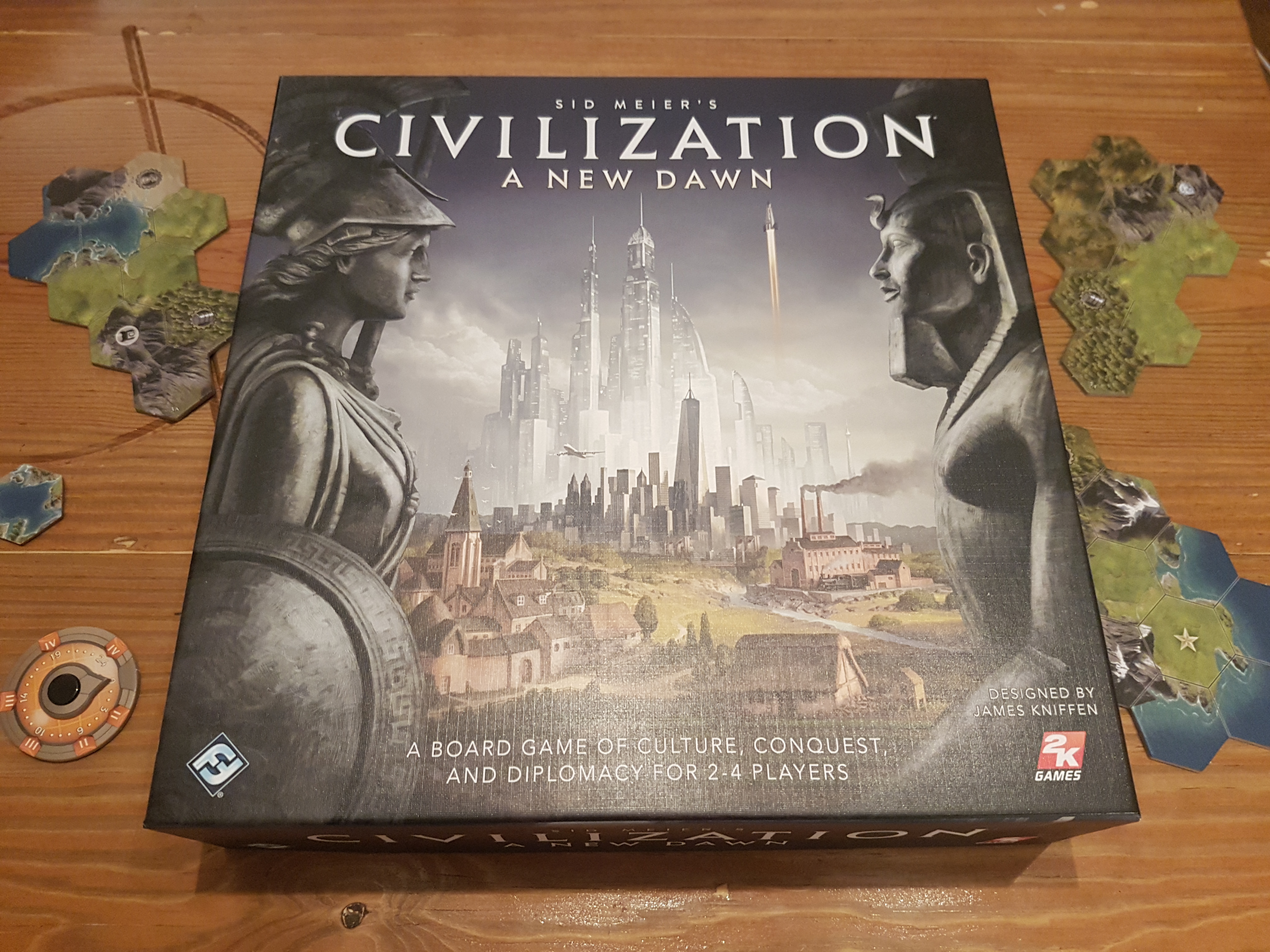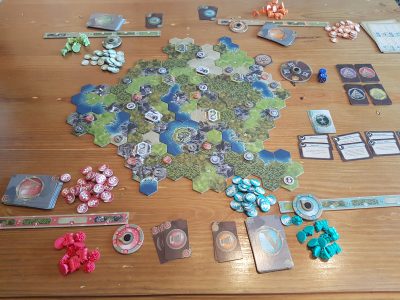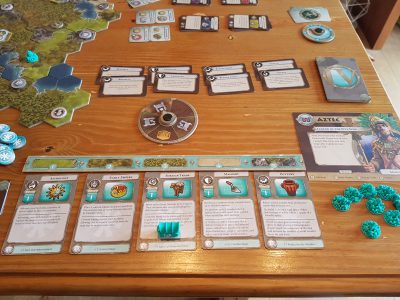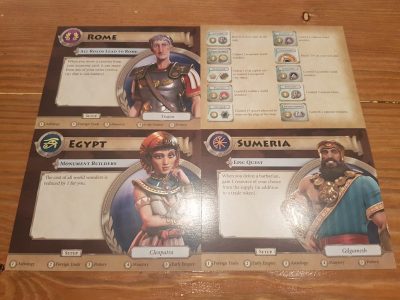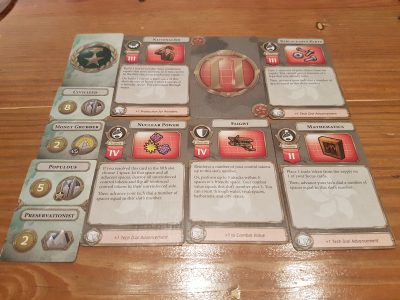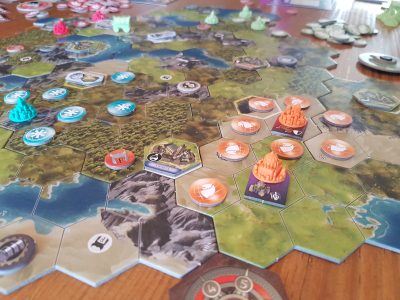Civilization: A New Dawn is the brand-new board game adaptation of the famous PC franchise, Sid Meier’s Civilization. Based upon the sixth instalment of the series, with similar leaders and hexagon tiles, Civilization: A New Dawn is designed for 2 – 4 players. The game is much shorter in length than an average Civilization game on the computer, lasting around 1.5 – 2 hours, though the area control concepts are still just as strong. This isn’t the first Civilization game to be released by Fantasy Flight Games but does this title do the franchise justice? Let’s find out!
Taking a lot of inspiration from the video games Civilization: A New Dawn sees players controlling cities, expanding their control, sending caravans out across the map to trade, constructing world wonders and attacking both other players and barbarians alike. The objectives do not always involve combat though, like with the rest of the franchise victory can be achieved by science and wonders instead.
At the start of the game three objective cards are revealed, each offering two choices. To win a player must complete one objective from each card. Players start off with 5 level-I action cards, an action upgrade deck, a leader sheet, a single capital city and piles of cardboard control tokens, plastic caravan models and plastic city models. The 5 action cards are organised along a focus row, with the order determined by their leader. This focus row is the main component behind the action mechanisms in the game.
The five action cards are placed below the focus row bar, falling into 5 indicated positions. Denoted as 1 – 5 and a terrain type, these slots become progressively better. For example, slot 4 is desert. Activating a card in this slot allows the action to be done on a desert terrain hexagon, or below, but not on a mountain, which is slot 5. It isn’t always necessary for actions to be taken high up in the focus row, but it does often mean players must cycle through most of the available actions. Once an action is taken the card is moved to slot 1, while the rest slide up a slot to fill the gap.
The 5 basic actions are only the tip of the iceberg of what players can do, each coming from their own type of actions which can be upgraded. The types are: culture, science, economy, military and industry. Culture sees players able to place control tokens onto the board surrounding their cities. These can only be placed onto hexagons equal to or below the terrain type of the focus row slot the card was activated from. Control tokens don’t do too much on their own but can help players gain one-time use resource tokens or natural wonders, which give on-going resources.
Science sees the player advancing their tech dial by the number of the card slot on the focus row. When increasing the tech dial if a player passes the level-II or above markings on it that player can dip into their action upgrade deck. Each action card has 3 upgrades, up to a maximum of level IV. Any action can be upgraded to the new level triggered by the tech dial. Note that level IV is when nukes become a bonus scientific action!
Economy is a staple early on but seems to drift out of focus towards the end of the game. Playing the economy card enables players to send caravans out across the map, moving a set number of hexagons across terrain defined by the focus row. Trading with other players or city states gains you little bonuses, such as trade goods or defence pacts, at least until conflict breaks out.
Military has two purposes it allows a player to attack from a certain range denoted on the card itself or reinforce control tokens. Reinforced control tokens add to defensive scores in combat and can simply bounce back barbarians coming your way. Attacking is a slight oddity in the game as combat is rather abstracted away behind the control tokens. No troop units or tokens adorn the board.
Players can gain combat benefits from trades, wonders and leader sheets which are all taken into account alongside a dice roll. Other aspects come into play depending on what is being attacked. For example, barbarians get a defence bonus based upon the territory type they reside on. It is a bit of a wishy-washy system that works but that’s about it.
The final action type is industry, which players will use to construct a new city or wonder. Constructing a city depends on the focus row slot for the terrain it’s being built on, while the level of the card dictates the proximity to your control it must be within. Wonders are where things get interesting as building them depends on the number of the focus row slot plus any trade goods or resources the player has available. Wonders once built have a token that slides under a city, so if that city falls it goes with it. On top of this, wonders come with special abilities that adapt the rules slightly for that player. These aren’t game breaking but some will certainly be highly fought over!
Play goes around the table with each player activating a card on a turn. Each time play comes back to the starting player an event is triggered that mostly effects the barbarians. The events see barbarians respawn, barbarians move in a direction on the board, mature cities (surrounded by control tokens) gaining a trade good or nothing. Movement sees the starting player rolling for the direction in which barbarians move. If a barbarian moves into a non-starting city it is unfortunately destroyed, so reinforcing control tokens is highly important. The game continues until a player wins by completing a third objective and securing victory.
A lot of token based games have lengthy setup and tear down times. Civilization: A New Dawn gets around this setup issue as most of the board starts free of tokens with only a few city states, player cities and barbarians to place. Instead of the tokens taking the time it is the board construction that can take a little bit of time, resulting it me finding it best to stick to the pre-defined board setup in the rulebook. The tear down time isn’t to be scoffed at, as players throughout the game will have undoubtedly spread a lot of control tokens. Whether you’re setting up for another game or putting the game away it can take a good 10 minutes to get it all neatly back into the box.
The focus row is a brilliant design element of Civilization: A New Dawn. Mechanically the balance that comes from waiting to use actions, to make them more powerful, is an incredible satisfying one. Players will have to constantly trade-off using an action they need to take with waiting to allow it to be better. Being nit-picky, for all the incredible gameplay elements that result from the focus row, sliding cards along the table is cumbersome and happens nigh on every turn. The sliding is only made worse when tokens get added on top, though I’m unsure how they could improve this system in a board game.
All knowledge of the Civilization video games aside there are odd choice for resources, especially as they are solely used for constructing wonders. Marble, mercury, oil and diamond may spring to mind when thinking about what a civilization is famous for or remembered for using. Nevertheless, they do not really make sense when it comes to constructing things such as the Pyramids or the Pentagon. It seems like an odd design choice, when the more generic stone, wood, iron and food make more logical sense for construction.
The random movement of the barbarians is simulated rather well via the direction movement and a dice roll, however I feel the movement rules heavily adapted to fit. If the barbarian was to be moving onto a water tile they don’t stay put instead they boat across. If they would be journeying off the edge of the board, again, they don’t stay put they head the opposite direction. While the boating across water aspect I can understand, as players cannot do this, intuitively players that the barbarians don’t move. By including special rules for the barbarian movement it begs the question why players are constantly stumped by bodies of water, despite being in more advanced cities.
The small city and caravan models help what is otherwise a flat game pop somewhat off the table.
The hexagons that make up the board are smaller in size than I had originally anticipated, though the board is still of decent size once the board pieces have been arranged. Despite their size, the artwork on the tiles creates a stunning map to play on. This attention to visual quality is reciprocated across all of the cards, which have plenty of room for the text to be easily readable. The only minor slip in the clear nature of the visual presentation is the light green used for the green control tokens. Being so light it is a little harder at a glance to tell if they are reinforced compared to the other colours.
Combat is the one thing everyone has complained about when it comes to Civilization: A New Dawn, and it is pretty lacklustre. It has been watered down to token vs token instead of units on the board and this fails to excite anyone. It drives a feeling of being against the board, as for the most part combat will be resolved against barbarians, then potentially against city states, before the notion of attacking another player even crosses a your mind.
Chances are that two out of the four wonder types will feature as objectives. In your first game or two you may sit their thinking that these are a clear route to victory and ignore the other types. Do this at your peril! There are some extremely powerful wonder based abilities that should be fought over. Take the modern age wonder of the Pentagon for instance; at least 4 other wonders of the military type must be built before the Pentagon can even come up as an option to be built. Yet, it allows for combat to have now range limits for that player, a huge advantage that may otherwise not surface.
The major let down of the objective card system is that there are only 5 cards included in the box. This means that players will never be tasked to do two objectives from the same card as there aren’t other combinations. Yes, this does stop the potential for the same objective appearing on more than one objective card but the lack of variety hampers the game more than duplicates would. As with the video game series there is the potential for the game to end abruptly and slightly anti-climactically. Whilst this is the case they do drive the importance of constantly making strides forward and trying to find the optimal order of actions.
To some extent the dice adds an element of slight exhilaration. At the time of the roll you are captivated by the potential of a high roll. Afterwards you can step back and realise that this is something players have no influence over. While there are ways to get bonuses, with no way to re-roll you are stuck with whatever the die shows. It is most noticeable when players start to rack up enough bonus points that they can completely ignore the dice rolls against barbarians and then combat starts to feel worthwhile. The randomness can lead to some players feeling like the board is playing them, as if they lack control over what occurs. I’m sure a different, less luck based system, could have been designed for such an iconic franchise.
The positives and negatives of the Civilization video game franchise have been translated across into the board game medium. There are two stages of the Civilization board game, build up and action. The latter is where the entertainment flourishes, though the anticipation makes the first bearable. Unfortunately, in an hour and a half game the first 45 minutes to an hour will be this build up time. Starting out with nothing players will slowly but surely start to expand out, building cities and teching up. At around the half way point there is a tipping point where a snowball effect starts to occur. Players will now have better technologies, access to trade goods or resources and as a result doing additional things becomes easier.
While initially each turn made a little step towards improvement, leaps and bounds are being made. Now players are close enough proximity-wise, with decent enough cards so that bombing runs and even nukes are possible. As everything comes to a climax the game is over, almost but not quite cut short. For all the issues combat has, in this final period of the game combat feels worthwhile and concludes an experience that makes players want to come back for more. It left me “needing” to work out what I could have done better. If only the excitement and enjoyment of the latter half of the game could be somehow replicated throughout then this would be an instant hit, rather than just a solid experience.
[Editor’s Note: Civilization: A New Dawn was provided to us by Asmodee UK for review purposes. The game is currently available on 365 Games for £49.99. It is also available from local UK board game stores, find your local store here]

